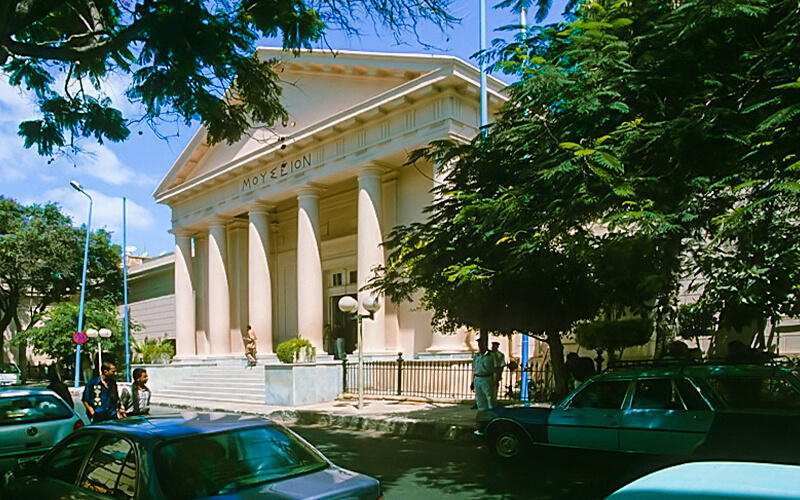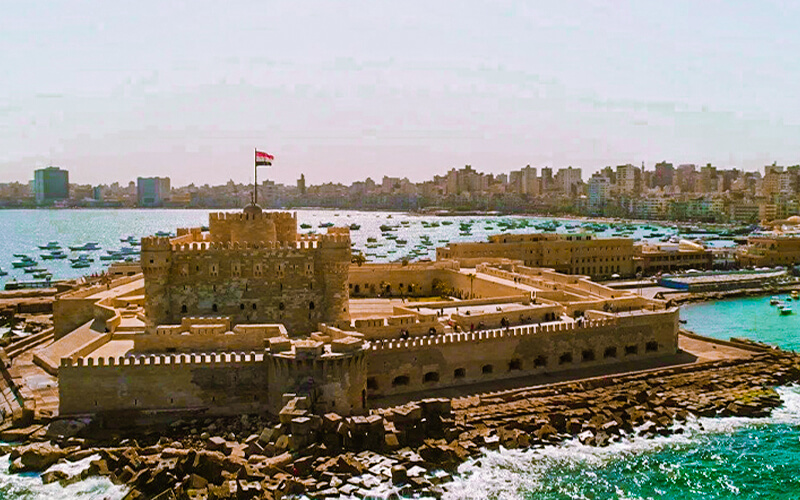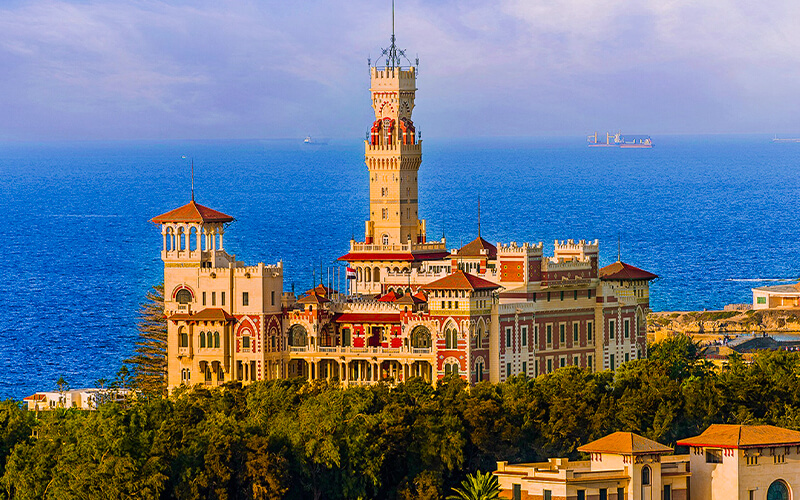Graeco-Roman museum
The Greco-Roman Museum Alexandria is in Egypt and it is in the city of Alexandria. Artifacts from Ptolemaic and Roman times are on display, as are many other artifacts found in and around Alexandria.
There are many rare artifacts in the museum, such as a white marble head of Julius Caesar, a marble head of Alexander the Great, and a Roman mummy with a colorful portrait of the dead person.
History of Graeco-Roman museum
Around 1891, it was clear that Alexandria needed a museum to hold its historical items. When it opened in 1895, during the reign of Khedive Abbas Helmy II, the museum had eleven rooms for showing things. Due to ongoing excavations and new finds, the museum went from having twelve halls to twenty-five halls over the next few decades.
There are things from the time of the Pharaohs and the time of the Greco-Romans. The museum was responsible for finding two critical tombs. One was from the Ptolemaic period and was found in the Wardian market. The other was from the Roman period and was found in the Wardian market. Both were then dug up, rebuilt, and moved to the museum’s tribal garden. Both of these tombs can be seen there now.
The Halls in the Graeco-Roman museum:
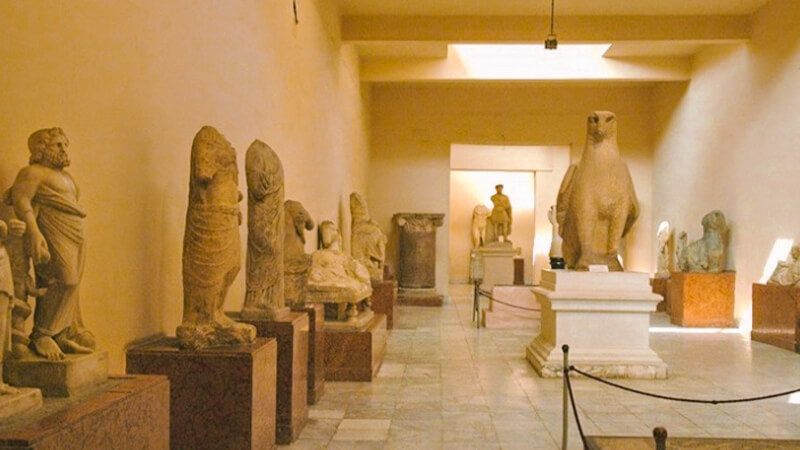
Statues inside Graeco-Roman museum Alexandria
Hall 1,2,4,5:
In Alexandria, some of the most important artifacts from the time of the Copts were found. One of these artifacts is a marble slab that shows Saint Apomina between two crouching camels. Another is a marble statue base with writing about cleaning the ancient Alexandria canal. There is also a collection of pottery in the shape of birds that shows Egyptian art, and there are also marble crowns that look like braided wicker baskets. The “Good Shepherd” statue, a picture of Jesus, was carved in the sixth century AD.
Hall No. 3:
In this hall, you can find treasures put there while the Serapeum Temple was being built and antiques.
Hall No. 6:
In this hall, you can see several statues and relics. There is a head of Alexander the Great made of red granite, a statue of the god Harpocrates, a statue of the Egyptian god Serapis, a statue of the Ptolemaic state’s god in the shape of a black bull, a head of Alexander the Great made of white marble, and two mosaic pieces on the eastern and western walls. A statue also stands there.
Hall No. 7:
The oldest things in this hall come from the Middle Kingdom. A massive figure of Ramses II made of pink granite
Hall No. 8:
The Ptolemaic and Roman mummies on display here show that starting in the Ptolemaic era, people paid much more attention to how the mummies were wrapped.
Hall No. 9:
In this hall are some things found in the Crocodile Temple in the town of Batn in the Fayoum region. On the west wall of the hall, there is a piece of an obelisk made of quartzite with hieroglyphics carved into it. There are also two panels made of limestone with Greek writing on them. Greek words are written on the entrance to the wooden temple. There are vases and figures in the collection that show gods from both Greek and Egyptian mythology.
Hall No. 10:
The name of this room refers to one of the city’s Greek residents named, John Antoniades. The museum’s archaeological holdings have been donated.
Hall No. 11:
In this hall, the influence of Greek aesthetics on the Egyptian Art School is seen.
Hall No. 12:
In the middle of the hall is a giant Roman emperor statue dressed in imperial military garb. There are also giant statues of Ptolemy IV and Ptolemy VI, a marble statue of a woman, a statue of Bacchus, the heads of several Ptolemaic queens, a leader of Alexander the Great found at the bottom of Abu Qir Bay, and a statue of the god of the Nile.
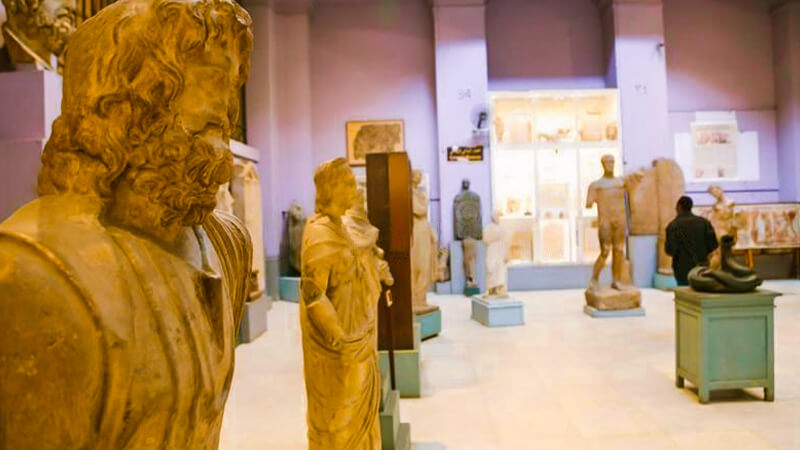
Statues from different eras inside the Graeco-Roman museum Alexandria
Hall No. 13:-
In the middle of the room is a statue of a Roman emperor wearing the clothes his army would have worn. The niches in the walls hold one of four marble statues of philosophers or preachers.
Hall No. 14:
This area contains some of the most magnificent statues of Roman emperors that can be found elsewhere in the world.
Hall No. 15:
This hall in Alexandria was built with parts of Greek and Egyptian architecture. These things have been around for a long time.
Hall No. 16:
In this hall are statues of Keres, the goddess of agriculture, a giant eagle, the god Tekhi, the goddess Venus, the god Apollo, and Aphrodite, the goddess of love and beauty.
Hall No. 17:
The largest room in the museum showcases a variety of Roman artifacts, including wreath coffins, black basalt tablets, a gigantic figure of an individual sitting on a throne thought to represent Emperor Diocletian, and two enormous marble statues of the gods Serapis and Hercules.
Hall No. 18:
This section has a wide range of Greek and Roman dolls, some of which are stuffed animals. During those times, dolls like these were used as toys for children and as decorations in homes and temples.
This hall is one of the most significant artifacts from ancient Alexandria, and it offers a plethora of information on Alexandrian women living during the Ptolemaic period. This information includes details about the women’s social rank, beauty standards, and hair and clothing styles.
Hall No. 19:
The most exciting part of the hall is a mosaic floor with an open flower and a cup with spiraling hands.
Hall No. 20:
This room contains a significant quantity of collections and flasks uncovered in the graves of Shatby and Hadra. These cemeteries were located nearby.
Hall No. 21:
This room has a fantastic collection of lamps, pots, and cups from the Ptolemaic period of Roman history.
Hall No. 22:
This hall is full of things from the ancient city of Canopus that Prince Omar Toson was kind enough to give. Among these artifacts are a one-of-a-kind white marble statue, the marble head of an Asian idol, and a group of ceramic jugs.
Alexandria has a long and well-known history, but there isn’t much left to show. The city has been built on top of itself more than once to fit in the small space between the Mediterranean Sea and the Nile River’s wetlands, which are behind it. Considering how many invasions, sieges, and air attacks destroyed ancient Alexandria over its long history; it becomes much easier to see why so little of it still stands today. Check our Egypt Vacation Packages include trips to the country’s most well-known attractions. If you choose one of these packages, you may be able to go back in time and enjoy an incredible experience in Egypt.

